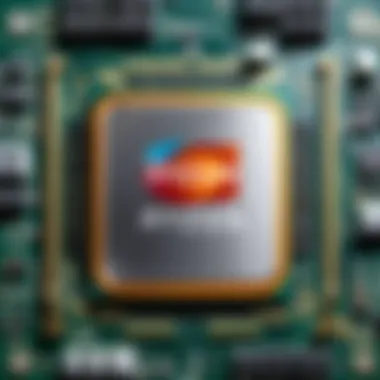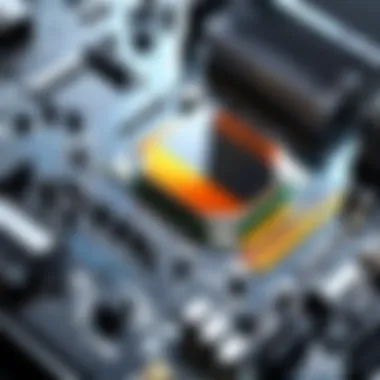Selecting the Best Motherboard for AMD Ryzen


Intro
Selecting the right motherboard for your AMD Ryzen processor can feel a bit like searching for a needle in a haystack, especially with the sheer number of options available in today's market. If you're a tech enthusiast or a casual gamer, the decision isn’t just about aesthetics; it’s about performance, compatibility, and future-proofing your rig.
A motherboard serves as the backbone of your computer— like the framework of a house. It connects all other hardware components together. Thus, the brand you choose can have significant implications on your overall experience. Some brands have carved out a reputation for reliability and innovation, while others may falter in performance or customer support, leaving users dissatisfied.
This article will guide you through the key aspects to consider when choosing a motherboard brand for Ryzen processors. From understanding chipset compatibility to reviewing essential features such as power delivery and thermal management, we aim to equip you with the insights necessary for making a wise investment. Whether you’re building a gaming machine that can tackle the latest titles or assembling a workstation to handle demanding applications, your choice of motherboard is crucial.
Let’s roll up our sleeves and dive into the core of what makes a motherboard brand stand out in the crowded marketplace.
Preamble to Ryzen and Motherboard Compatibility
Choosing the right motherboard when working with AMD Ryzen processors is akin to picking the best foundation for a building. Without a solid base, even the most striking structures can falter. This section explores the critical dynamics of motherboard compatibility, the essence of Ryzen processors, and their symbiotic relationship. Understanding this can dramatically influence your computing experience, whether you’re gaming, creating content, or running intensive applications.
Overview of AMD Ryzen Processors
AMD Ryzen processors have carved out a significant niche in the competitive landscape of computing. Known for their robust performance and multi-threaded capabilities, these processors cater to a diverse range of users. From entry-level models like the Ryzen 3 series to powerhouse offerings such as the Ryzen 9, there’s something suitable for nearly every preference. This adaptability has earned AMD a loyal following, particularly among tech aficionados excited about pushing their systems to the limit.
Moreover, Ryzen processors leverage technology that supports simultaneous multi-threading, enabling efficient task management. This means that for heavy workloads, users can expect seamless performance, making these processors a favorite for content creators and gamers alike. Hence, it’s crucial to pair these processors with motherboards that can truly harness their potential, allowing all their features to shine.
Importance of Motherboard in Performance
The motherboard plays a pivotal role in determining system performance and reliability. Here are a few essential aspects:
- Socket Type: The motherboard must have the correct socket compatible with Ryzen processors, which typically utilize the AM4 socket. Without this compatibility, the processor simply won't fit.
- Chipset Selection: The chipset of a motherboard dictates the features and performance enhancements one can tap into. Choosing a chipset that pairs well with your Ryzen processor is vital. For example, X570 chipsets support advanced functions such as PCIe 4.0, which provides higher bandwidth for next-gen graphics cards or NVMe SSDs.
- Power Delivery: A good motherboard will have robust VRMs (Voltage Regulator Modules) that ensure efficient power delivery to the CPU. This is particularly significant for users interested in overclocking, as inadequate power can lead to instability.
- Cooling Solutions: Many Ryzen processors can run hot, and having a motherboard that supports efficient cooling solutions is a wise consideration. Well-placed fan headers and heatsinks can mean the difference between a stable system and one that struggles under load.
"Choosing the right motherboard is not just about aesthetics or brand fame; it’s about understanding the architecture that will elevate your Ryzen experience to new heights."
In summary,matching the right motherboard with a Ryzen processor opens the door to brewing possibilities, making your hardware investments not just worthwhile, but rewarding. Careful consideration of compatibility will ultimately lead to a smoother operation and enhanced capability, serving both casual users and hardcore enthusiasts.
Key Features to Look for in a Motherboard
When diving into the world of motherboards intended for AMD Ryzen processors, one quickly realizes that not all boards are created equal. The motherboard serves as the backbone of any computer build, much like the keystone in an arch, supporting everything that rests upon it. Therefore, understanding the key features to consider in a motherboard isn't just advisable; it's imperative for anyone looking to get the most out of their Ryzen experience. Let's explore some of the critical elements to keep in mind while making your choice.
Socket Compatibility and Chipset Selection
The compatibility between the Ryzen processor and the motherboard socket is foundational. Ryzen processors utilize the AM4 socket, which has been a standard for several generations. However, this isn't where the story ends. The underlying chipset plays a significant role in determining the capabilities and features of the motherboard.
Different chipsets such as B450, X470, and the newer B550 and X570 bring various functionalities. For instance, the B550 chipset offers PCIe 4.0 support, which can significantly enhance data transfer rates and overall performance. Picking the right chipset not only dictates the features you can leverage but also the future-proofing of your build. Ensure to check the specific requirements based on your CPU model, especially if you are eyeing any potential upgrades in the future.
RAM Support and Overclocking Capabilities
RAM options are another pivotal aspect of motherboard selection. Not all boards will support the same amount of memory or the same speeds. Look at the specifications—some motherboards can handle faster clock speeds and more DIMM slots than others. If you plan to overclock your RAM, you’ll want a motherboard that provides robust support for this by offering an array of voltage settings and profiles.
Moreover, the quality of the memory slots can affect stability during overclocking. Boards with better designs, like reinforced slots, can handle heavier memory modules with less strain. Knowing your personal needs can help you avoid those bottlenecks down the road.
Think about it—maximizing RAM speeds without the right motherboard support can leave performance on the table.
Expansion Slots and Connectivity Options
Consideration of expansion slots and connectivity is like mapping out your expansion possibilities. You might have plans for future upgrades or additional components, so it's best to ensure ample PCIe slots and connectivity options. A solid motherboard should offer a mix of full-length PCIe slots, M.2 slots for SSDs, and sometimes additional USB ports for peripherals.
Having multiple x16 slots available, or even a couple of x1 slots, boosts your upgrade potential. If you’re into gaming or content creation, make sure that your chosen board allows for graphics cards, sound cards, and maybe even capture cards if you're going that route. Connectivity also includes the number and type of USB ports—newer motherboards can make use of USB 3.2 and even USB-C, catering to modern devices.
BIOS Features and Updates


Having an intuitive BIOS can make all the difference when configuring your motherboard. A user-friendly interface that provides clear options for adjustments can save time and headache. Modern motherboards often come loaded with features such as one-click overclocking and comprehensive monitoring tools.
Keeping your BIOS updated is equally essential. Manufacturers frequently release updates that might fix bugs or enhance compatibility with new components. A good board should offer a straightforward way to update the BIOS, sometimes even from the BIOS itself without needing an operating system.
The importance of a good BIOS cannot be overstated, as it directly impacts your experience with your system.
"Choosing the right motherboard can be akin to laying down a solid foundation for a house; without it, everything else may crumble if not well-supported."
Building your PC with Ryzen processors ensures exciting performance, but selecting the right motherboard is what truly unlocks the next level. Make these considerations carefully, and you're on your way to a setup that meets your needs and expects growth well into the future.
Top Motherboard Brands for Ryzen
When diving into the realm of building or upgrading a computer with Ryzen processors, the choice of motherboard can be the make-or-break factor. This section hones in on some of the most recognized motherboard brands, each crested with its unique features, performance metrics, and user experiences that make them stand out in the marketplace. With the right motherboard, not only does the Ryzen processor soar to its maximum potential, but it also provides users with the flexibility needed for future upgrades or specialized uses.
ASUS: Innovation and Reliability
Popular Models for Ryzen
ASUS stands tall in the motherboard arena, known for its innovation and reliability. Among its popular models, the ROG Crosshair series often receives accolades for its robust power delivery and extensive overclocking capabilities. The Crosshair VIII Hero is particularly well regarded for its precision tuning capability, allowing enthusiasts to push their Ryzen processors to new heights while maintaining stability.
A unique advantage of these models lies in their comprehensive BIOS options, which cater to both seasoned overclockers and newcomers. However, it’s worth noting that with enhanced features comes a potentially steeper learning curve for the inexperienced user.
User Feedback and Performance
User feedback plays a vital role in understanding a product's real-world performance. Many ASUS users rave about the Aura Sync lighting feature that seamlessly integrates with other components for a cohesive build aesthetic. Moreover, forums are replete with positive remarks on user-tech support, a lifesaver in situations when a component doesn’t act as it should.
However, some have raised eyebrows at the pricing, which can lean toward the premium side. This leads to the consideration of whether the investment aligns with individual needs, especially for budget-conscious builders.
Gigabyte: Versatility and Value
Overview of Key Features
Gigabyte is another brand that manages to strike the right balance between versatility and value. With an expansive range of motherboards, one can find quality options that fit different budgets and specifications. The AORUS series is particularly noteworthy, offering excellent thermal solutions and durability.
These motherboards generally come with a solid array of features such as multiple USB ports, reinforced PCIe slots, and built-in Wi-Fi, making them appealing for a wide range of users. Their adaptability to both casual gaming setups and more demanding builds is commendable, but one must be cautious about compatibility with all Ryzen variants.
Pricing Structure and Market Position
When examining Gigabyte’s pricing structure, it’s evident they offer something for everyone. From entry-level boards to high-end models, Gigabyte fills numerous price brackets. Their market position is bolstered by solid performance metrics and features like Q-Flash Plus, enabling easy BIOS updates without the need for a CPU installed.
However, potential buyers should keep an eye on reviews, as some models might come with limitations that could affect performance in specific scenarios.
MSI: Gaming-Optimized Solutions
Gaming Features and Aesthetics
MSI has carved a niche for itself, especially in the gaming sector. Known for eye-catching designs, their MEG and MPG series are engineered with a gamer’s experience in mind. Features like Steel Armor reinforcement and advanced cooling solutions are highlights appealing to performance-hungry gamers.
A key characteristic that enhances the gaming experience is the Gaming Mode found in their BIOS, which optimizes settings based on the user’s needs for specific games. Nevertheless, while aesthetics might draw one in, the underlying power management and heat dissipation systems are crucial for ensuring stable performance under load, which can be a hit-or-miss depending on the model.
Customer Recommendations
Feedback from the gaming community frequently points to MSI’s Dragon Center software, which enables real-time monitoring and overclocking—a critical feature for gamers looking to fine-tune their hardware.
That said, user recommendations aren't without caveats; there have been instances of driver issues that have led some users to seek alternative brands for a more straightforward experience.


ASRock: Affordable Performance
Target Audience and Market Strategy
ASRock has emerged as a favorite among budget-conscious users looking for good performance without splurging. Their targeted approach is evident in their lineup, which includes models designed for everyday use as well as for gamers and creators. The Phantom Gaming line is particularly made for those who want solid features at an attractive price point.
Their strategy includes releasing boards with essential features, cutting back on the not-so-essential ones, which makes them appealing to individuals who prioritize functionality over frills.
Model Comparisons
When comparing ASRock models such as the B550 Steel Legend to counterparts from other brands, you’ll find that while many standard features are included, there are less luxurious extras. Gamers might feel a lack of RGB lighting or intuitive software compared to pricier competitors but enjoy decent performance without worrying about bank balance.
Strengths and Weaknesses
ASRock's strengths lie in delivering solid performance. However, detractors often point to some reliability issues or customer support complaints, which can deter potential buyers looking for long-term investments. While their motherboards might not be as flashy, they often provide great value for those who are resourceful and willing to tweak settings for better performance.
Comparative Analysis of Motherboard Brands
When it comes to building a system that houses an AMD Ryzen processor, one cannot overlook the significant role of the motherboard. It acts as the backbone of your build and dictates not just compatibility, but performance, stability, and growth potential. A comparative analysis of motherboard brands enables users to navigate through the nuances of what each manufacturer offers. This section dissects the key elements to consider when weighing different brands, paving the way for informed choices that align with specific needs and preferences.
Benchmarking Performance Across Brands
To gauge the performance of various motherboard brands, one must dive into rigorous benchmarking studies that account for several metrics. Frame rates, temperature management, and stability during high-load conditions are a few of the critical performance indicators. For instance, ASUS motherboards often lead the pack in thermal performance, maintaining low temperatures even under extensive use during gaming sessions. Meanwhile, Gigabyte tends to shine with solid power delivery systems that ensure the processor receives ample power for overclocking.
It’s essential to mention real-world testing, where performance in gaming and other applications can differ greatly from synthetic benchmarks. Some brands may excel in CPU tasks but falter when it comes to graphic-intensive processes. It’s these nuances that can significantly affect user experience. Gathering data from forums, reviews, and benchmarking sites can paint a clearer picture of how each brand handles real-world scenarios.
Key Performance Metrics to Consider:
- Thermal performance: Ability to manage heat efficiently.
- Power delivery: How well the motherboard delivers power to the CPU, especially during overclocking.
- Stability: Performance consistency under load.
User Experiences and Community Perceptions
In today’s interconnected world, the voice of users holds tremendous weight. Whether it is through online forums, social media platforms like Facebook, or community discussions on Reddit, the experiences shared by others can greatly inform your decision-making process. Many users frequently give firsthand accounts that highlight both the pros and cons of different brands.
For example, MSI has a strong community following among gamers who appreciate their gaming-specific features and overclocker-friendly designs. Yet, there are also feedback loops discussing potential concerns, such as driver stability or compatibility issues with certain setups.
It's worth emphasizing that brand perception isn’t just about numbers; it encapsulates the entire user experience. Customer service and warranty offerings can also sway opinions, as positive interactions can lead users to advocate for a brand, while negative experiences can tarnish reputations. Thus, keeping an ear to the ground can provide valuable insight into how a brand is received and its overall reliability.
Understanding the community’s perspective can save you time and money, often steering you clear of products with known flaws or buildup of negative experiences.
In summary, the comparative analysis of motherboard brands for Ryzen processors encompasses both technical specifications through benchmarking and the human element highlighted by user experiences. Each brand presents a unique amalgamation of performance capabilities, community perception, and user satisfaction, all critical factors that play into the ultimate decision when choosing a motherboard.
Considerations for Specific Use Cases
When selecting a motherboard for AMD Ryzen processors, it’s crucial to understand that not all motherboards are created equal. Individual needs often dictate the best choice. Whether one is a gamer, a content creator, or simply budget-conscious, various factors come into play. Each of these use cases has specific requirements that can significantly affect performance, efficiency, and ultimately, satisfaction.
Gaming Rig Configurations
For enthusiasts rioting to build a gaming rig, the motherboard acts as the backbone. It needs to support high-speed RAM, have sufficient PCIe slots for graphics cards, and offer robust cooling solutions. Gamers typically look at boards that are overclock-friendly, enhancing CPU and RAM capabilities. Here, socket compatibility is non-negotiable; the latest chipsets, like the X570 or B550, provide advanced features such as PCIe 4.0 support. This feature allows gamers to leverage faster graphics cards and SSDs, enhancing their overall experience.
Moreover, consider the aesthetics too. RGB lighting has become a huge trend among builders. A motherboard that complements these setups might sway decision. Important features include:
- High-quality capacitors for longevity and stability
- Multiple M.2 slots for fast storage configurations
- Integrated Wi-Fi and Bluetooth for ultimate convenience
"Choosing the right motherboard can mean the difference between a great gaming experience and an average one."


Content Creation and Professional Applications
Content creators often require motherboards that can handle heavy workloads. Software such as video editing suites, graphic design tools, and 3D rendering programs are resource-intensive. Therefore, features like RAM support, multi-core CPU compatibility, and Thunderbolt ports are paramount. Select a motherboard that supports high-capacity RAM, ideally 32GB or more, as this lets creators juggle multiple applications smoothly.
Consider the chipset too; higher-end ones, like the X570, not only support more simultaneous tasks but can also provide features like better USB support. This means faster data transfer speeds for external drives or other peripherals. Other relevant components include:
- Multiple expansion slots for added GPUs or storage options
- User-friendly BIOS interfaces for easy setup and adjustments
- Solid power delivery systems to maintain stability under load
Budget-Conscious Selections
For many, keeping costs in check is a top priority. Thankfully, excellent options exist within the realm of Ryzen-compatible motherboards. A smart budget shopper should focus on essential features that match their needs without overspending. Mid-range options like the B450 or B550 chipsets are often enough; they provide solid performance at a reasonable price.
Evaluate the following when considering budget options:
- Expandable options: Some boards allow for future upgrades, making them a wiser investment in the long run.
- Warranty and support: Brand reliability can vary greatly, so it’s wise to check customer reviews about warranty services.
- User-friendly features: Simpler motherboards lacking the extra bling often come at more affordable prices, making them a good fit without sacrificing quality.
When it comes down to it, a careful selection tailored for specific purposes not only optimizes performance. It also ensures a satisfying experience, regardless of one’s ambitions or constraints.
Future Trends in Motherboard Technology
The landscape of motherboard technology is always evolving, driven by advancements in processing power and user demands. Understanding these trends is crucial for anyone considering a purchase, especially as AMD Ryzen processors gain popularity. Staying ahead of the curve ensures that enthusiasts and casual users alike can make informed decisions that align with future capabilities.
Looking at how motherboards interact with CPUs, it's clear that upcoming technologies can significantly impact performance and usability. By exploring the latest chipsets and emerging features, users can prepare for a dynamic shift in their computing experiences.
Upcoming Chipsets and Their Implications
The forthcoming chipsets promise to bring a host of enhancements that users need to keep an eye out for. With each new iteration, manufacturers like ASUS and MSI are not just keeping up with the competition; they're often setting the pace.
- Increased Core Support: The trend is leaning towards chipsets that support more cores, meaning Ryzen processors can fully utilize their potential. Take, for example, the AM5 chipset, which is expected to offer better support for multi-core workloads, thus enhancing performance in gaming and productivity applications.
- Enhanced PCIe Support: The shift towards PCIe 5.0 is another noteworthy development. This would allow faster data transfer rates, ideal for graphics cards and storage solutions, which could result in noticeable performance increases in gaming and video work.
- Integrated Networking Solutions: With online gaming and streaming at the forefront, motherboards are expected to feature robust integrated networking options, supporting faster Wi-Fi standards and more reliable Ethernet connections. This would lead to reduced latency and improved network stability.
These advancements in chipsets provide a glimpse into the possible performance increases. Each new feature could mean the difference between a stunning gameplay experience and frustrating lag.
Emerging Features and User Expectations
As the technology evolves, user expectations naturally follow suit. Today's consumers are more tech-savvy than ever, with a keen interest in how new features directly enhance their computing experience.
- Smart Connectivity: Features such as USB4 and Thunderbolt 4 are becoming essential for high-speed data transfer and peripheral connectivity. Users expect motherboards to support these protocols to ensure their systems remain relevant longer.
- AI Integration: There's a growing interest in integrating artificial intelligence to monitor system performance and optimize the user experience through adjustments in cooling, power distribution, and overclocking settings. The potential for motherboards to learn and adapt could drastically shift user interaction.
- User-Friendly BIOS: A trend towards improving the BIOS experience is critical as well. More intuitive interfaces that allow users to make adjustments quickly without sifting through intricate menus are on the rise. Simplifying the setup process will cater to both new users and veterans alike.
As manufacturers adapt to these expectations, we can foresee a shift in how we approach hardware selection. Staying aware of these trends is not merely about keeping up; it's about ensuring that the investment into a motherboard aligns with future needs, maximizing longevity and performance.
Ignoring the trends could result in purchasing a component that's outdated before it even leaves the box.
Finale: Selecting the Best Motherboard Brand for Ryzen
When it comes to pairing the right motherboard with your AMD Ryzen processor, the stakes are high. This isn't merely about fitting pieces into a case; it's about maximizing performance and ensuring longevity in your build. The best motherboard can make the difference between a smooth-running machine and one that struggles to keep up. A well-chosen motherboard enhances not just performance, but also system stability and upgradability. Thinking about how this component interacts with your processor, RAM, and even graphics cards reflects the completeness of your gaming or content creation experience.
Choosing the right motherboard brand matters significantly. Reputable brands often provide better design, design longevity, and extensive warranties, not to mention customer support. Each brand brings a unique flavor; for instance, ASUS is often lauded for its innovation and advanced features, while MSI leans heavily into gaming aesthetics. Understanding these differentiators can serve you well in making an informed choice. This is particularly vital for performance-critical applications like gaming, where every last frame counts.
Key Considerations:
- Budget: How much are you willing to invest? You're usually going to get what you pay for.
- Features: Do you require advanced cooling solutions or high RAM support? Not all boards cater to the same audience.
- Compatibility: Always double-check socket compatibility with your Ryzen CPU and available chipsets. This decision can save you a headache later.
In short, the selection process involves quite a bit of legwork and keen consideration of specific needs. Ask yourself: what does your ideal rig look like? Whether you're an esports enthusiast aiming for high performance or a tech aficionado wanting the best benchmarks, the right motherboard brand can lead you closer to those goals.
"The foundation of a powerful system is its motherboard, and its selection should not be taken lightly."
By synthesizing your knowledge from various sections highlighted in this article, you will be able to forge a durable and successful path in selecting the right motherboard brand for your Ryzen processor. Keep in mind the broader ecosystem of your computer among all brands, and you will make a more robust decision that stands the test of time.
Summarizing Key Points
- Compatibility is Key: Always ensure your motherboard supports the Ryzen chip you intend to use.
- Brand Strengths and Weaknesses: Different brands serve different market segments. Know which brand best fits your needs.
- Long-term Considerations: Think about future compatibility for upgrades to keep your system relevant longer.
- User Feedback: Community reviews often shed light on real-world performance and stability—a vital resource when making your decision.
- Features Matter: Advanced options like overclocking capabilities, connectivity, and BIOS support can hugely impact your performance.



